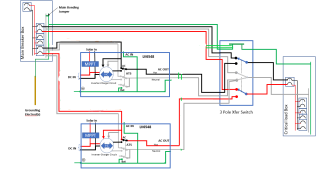I believe there will be current there also but there are some who think the objectionable current is caused by the extra ECGs so we need to determine what is correct.This is how I had planned to wire the units. I am almost certain that there will be current on the portion of the schematic you have marked. I am slowly coming to the conclusion that the field wiring of these units cannot fix this issue. I am hoping that the software will allow them to solve the problem internally. Without a definitive schematic directly from MPP it will take trial and error to figure this out.
It would be great if the new firmware had an option to not bond. It would be even better if the new firmware or some future firmware automatically did the bond on only one inverter when the inverters were paralleled.
With no firmware fix, the only solution seems to be to remove the bonding screw on all of the inverters except one. This is supposedly approved by MPP, but is it really? Will opening the inverter void the warranty? Will someone who is not all that comfortable with electricity and electronics to begin with want to do it? What if someone removes the wrong screw?
If you remove the screw on all inverters but one, ground fault clearing is now dependent on that one inverter. If you take that inverter out of your system and forget to replace the screw in one of the other inverters, you have no ground fault path in inverter mode. It might be better to remove all of the screws and use the neutral-ground bond in the main panel (or the subpanel if you don't have AC input). But that requires jumping the inverter's neutral input and output, which is not supported by MPP although they did not explain why.
As we have seen, it can be difficult to detect the objectionable current. How many people will be able to determine if their installation is safe or not?
Not an easy situation.
Last edited:





